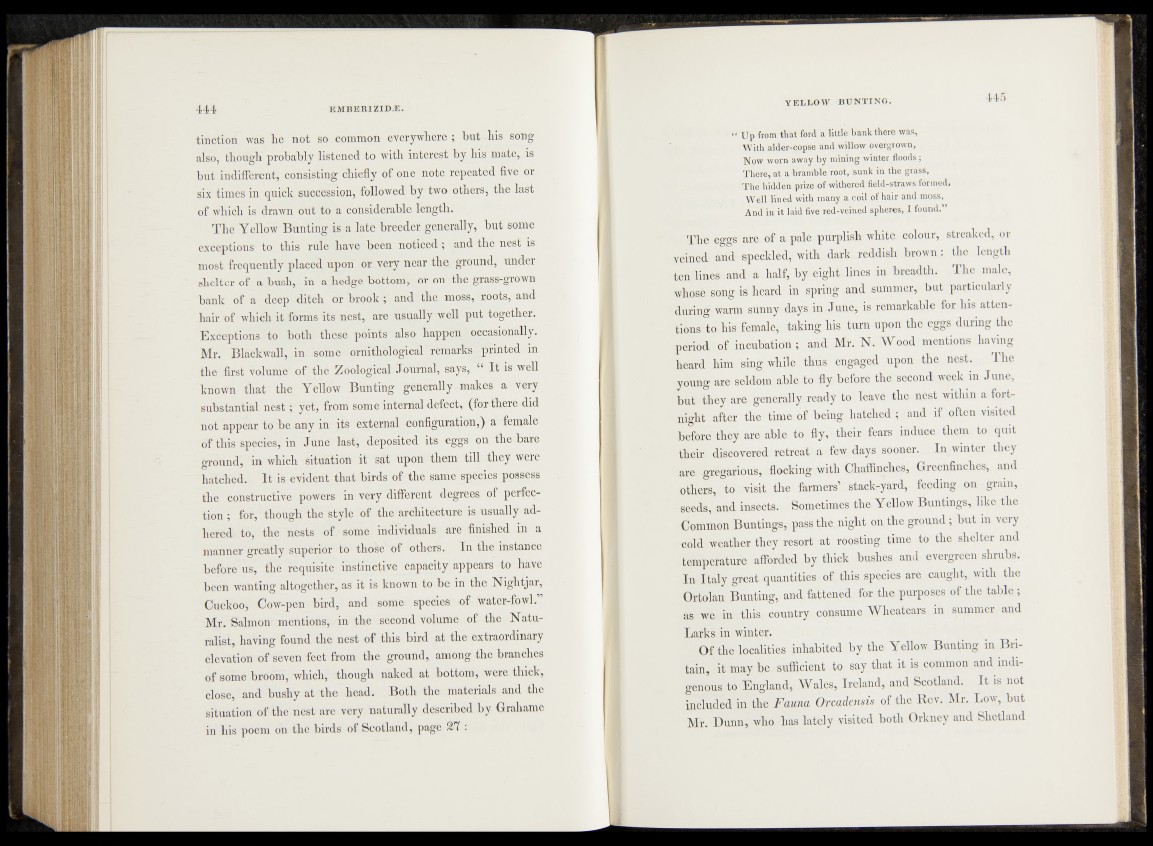
tinction was he not so common everywhere ; but his song
also, though probably listened to with interest by his mate, is
but indifferent, consisting chiefly of one note repeated five or
six times in quick succession, followed by two otners, the last
of which is drawn out to a considerable length.
The Yellow Bunting is a late breeder generally, but some
exceptions to this rule have been noticed; and the nest is
most frequently placed upon or very near the ground, under
shelter of a bush, in a hedge bottom, or on the grass-grown
bank of a deep ditch or brook ; and the moss, roots, and
hair of which it forms its nest, are usually well put together.
Exceptions to both these points also happen occasionally.
Mr. Blackwall, in some ornithological remarks printed in
the first volume of the Zoological Journal, says, ■ I t is well
known that the Yellow Bunting generally makes a very
substantial n e st; yet, from some internal defect, (for there did
not appear to be any in its external configuration,) a female
of this species, in June last, deposited its eggs on the bare
«■round, in which situation it sat upon them till they were
hatched. I t is evident that birds of the same species possess
the constructive powers in very different degrees of perfection
; for, though the style of the architecture is usually adhered
to, the nests of some individuals are finished in a
manner greatly superior to those of others. In the instance
before us, the requisite instinctive capacity appears to have
been wanting altogether, as it is known to be in the Nightjar,
Cuckoo, Cow-pen bird, and some species of water-fowl.”
Mr. Salmon mentions, in the second volume of the Naturalist,
having found the nest of this bird at the extraordinary
elevation of seven feet from the ground, among the branches
of some broom, which, though naked at bottom, were thick,
close, and bushy at the head. Both the materials and the
situation of the nest are very naturally described by Grahame
in his poem on the birds of Scotland, page 9N :
I Up from that ford a little bank there was,
With alder-copse and willow overgrown,
Now worn away by mining winter floods;
There, at a bramble root, sunk in the grass,
The hidden prize of withered field-straws formed,
Well lined with many a coil of hair and moss,
And in it laid five red-veined spheres, I found.”
The eggs are of a pale purplish white colour, streaked, or
veined and speckled, with dark reddish brown: the length
ten lines and a half, by eight lines in breadth. The male,
whose song is heard in spring and summer, but particularly
during warm sunny days in June, is remarkable for his attentions
to his female, taking his turn upon the eggs during the
period of incubation ; and Mr. N. Wood mentions having
heard him sing while thus engaged upon the nest. The
young are seldom able to fly before the second week in June,
but they are generally ready to leave the nest within a fortnight
after the time of being hatched ; and if often visited
before they are able to fly, their fears induce them to quit
their discovered retreat a few days sooner. In winter they
are gregarious, flocking with Chaffinches, Greenfinches, and
others, to visit the farmers’ stack-yard, feeding on grain,
seeds, and insects. Sometimes the Yellow Buntings, like the
Common Buntings, pass the night on the ground; but in very
cold weather they resort at roosting time to the shelter and
temperature afforded by thick bushes and evergreen shrubs.
In Italy great quantities of this species are caught, with the
Ortolan Bunting, and fattened for the purposes of the table ;
as we in this country consume Wheatears in summer and
Larks in winter.
Of the localities inhabited by the Yellow Bunting in Britain,
it may be sufficient to say that it is common and indigenous
to England, Wales, Ireland, and Scotland. It is not
included in the Fauna Orcadensis of the Rev. Mr. Low, but
Mr. Dunn, who has lately visited both Orkney and Shetland